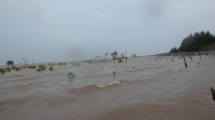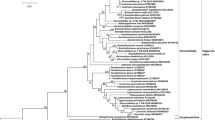Abstract—
The taxonomy of the genus Bittium from the Tarkhanian and lower Chokrakian is revised. It has been confirmed that the species B. reticulatum and B. tulskajense inhabited the Tarkhanian Basin. Two morphogroups are descended from B. tulskajense. In populations confined to thin silts, morph prodigitatum of B. tulskajense begins to separate in the Late Tarkhanian, which gave rise to B. digitatum in the Chokrakian. At the beginning of the Chokrakian, morph pseudodigitatum of B. tulskajense appears in populations on sandy silts, occupying an intermediate position in morphology between B. tulskajense and B. digitatum. During the Tarkhanian–Chokrakian, in B. tulskajense, the spiral sculpture is flattened and the collabral sculpture is reduced. However, ecologically dependent populations in which collabral sculpture again becomes the norm (morph plicatum of B. tulskajense) also existed. B. reticulatum began to evolve rapidly from the end of the Tarkhanian. The species B. agibelicum, which continued until the end of the early Chokrakian, quickly separated from it. B. reticulatum evolved into the subspecies B. reticulatum tschokrakense, which gave rise to B. binodulosum in the second half of the early Chokrakian. The systematic position of B. agibelicum was interpreted ambiguously for a long time due to its unusual morphology. Reconstruction of the lineage of B. reticulatum is used to substantiate the assignment of agibelicum to the genus Bittium, with a detailed morphological description of species and subspecies. Their intraspecific heterogenity due to the evolutionary process or arising under the local influence of external factors is discussed. The distribution of species is considered depending on the conditions of sedimentation and salinity fluctuations. The Tarkhanian gastropod communities are classified taxonomically for the first time, and their equivalents in the Chokrakian communities are proposed. The distribution of the Bittium species is shown in the Tarkhanian and Chokrakian communities is studied, and transformations in their niches changed during the transition from Tarkhanian to Chokrakian are demonstrated.





Similar content being viewed by others
Notes
Shallow-water coarse-grained sediments usually contain a mixture of several generations of shells. A generation is a totality of organisms that lived within or on a buried sediment at a certain moment in time. The last generation is the generation that lived before the final burial by the bottom sediment. Old generations are generations that lived in/on the sediment, which was later washed away or redeposited along with the skeletal remains of the organisms that previously inhabited it. The presence in the sediment of several generations with different preservation distinguishes samples of shallow-water sediments formed under conditions of a hydrodynamically active environment from deeper-water clayey or silty-clayey sediments, usually with one generation.
Populations of B. tulskajense m. plicatum are labeled as var., and similarly strongly deviant specimens in samples of common tulskajense are labeled as v. The morph pseudodigitatum is labeled as ps., prodigitatum—pr.
Most shells were attributed by Iljina to B. kamyshlakense. The specimens identified by her as B. reticulatum are labeled “ret”. In the material from Khadyzhensk, no shells were found, identified as B. kamyshlakense—only 29 specimens with the name B. reticulatum. Among Merklin’s unexamined material, a chamber with one shell was found, labeled by her as kamyshlakense.
Almost all shells are re-identified as Cerithium orientale (Andrussow) and B. binodulosum. Shells of B. agibelicum are very incomplete, most likely from the lower part of the section.
The collections of I.A. Goncharova, 1972 and O.V. Amitrov, 1961 are associated with precise bed occurrences.
Almost all shells are re-identified as Cerithium orientale (Andrussow) and B. binodulosum. Shells of B. agibelicum are very incomplete.
Some shells are re-identified as Bittium reticulatum tschokrakense, B. binodulosum and juvenile specimens of C. orientale.
Collections of I.A. Goncharova, 1972 and O.V. Amitrov, 1961 are associated with beds.
Some shells are re-identified as juvenile specimens of C. orientale.
REFERENCES
Ananiashvili, G.D., The territory of Georgia and adjacent regions in the Tarkhanian time, Tr. Geol. Inst. Gruz. SSR, New. Ser., 1985, no. 90, pp. 1–217.
Andrussow, N., Die fossilen Bryozoenriffe der Halbinsel Kertsch und Taman, Kiew: Selbstverlag des Verfassers, 1911, no. 2, pp. 49–88.
Babio, C.R., and Thiriot-Quiévreux, C., Gastéropodes de la region de Roscoff. Étude particulière de la protoconque, Cahiers Biol. Marine, 1973, vol. 15, pp. 531–549.
Bagdasaryan, K.G., Razvitie mollyuskovoi fauny Chokraka Gruzii (Development of the Mollusk Fauna of the Chokrakian in Georgia), Tbilisi: Metsniereba, 1965.
Bałuk, W., Lower Tortonian gastropods from Korytnica, Poland. Pt. I, Palaeontol. Polon., 1975, no. 32, pp. 1–186.
Barg, I.M., and Stepanyak, Yu.D., Mollyuski tomakovskikh sloev Yuzhnoii Ukrainy (Molluscs of Tomakovka Beds of Southern Ukraine), Dnepropetrovsk: Monolit, 2005.
Beluzhenko, E.V., Volkodav, I.G., Derkacheva, M.G., Korsakov, S.G., Sokolov, V.V., and Chernykh, V.I., Oligotsenovye and neogenovye otlozheniya doliny reki Belaya (Adygeya) (Oligocene and Neogene Deposits of the Belaya River Valley (Adygea)), Maikop: Adygea Gos. Univ., 2007.
Bidzinashvili, L.M., Mollusk fauna of the middle Miocene of the southern part of Imereti and its stratigraphic significance, Tr. Vsesoyuz. Nauchn.-Issled. Geol.-Razved. Neft. Inst., 1971, no. 115, pp. 40–55.
Bidzinashvili, L.M., Some little-studied mollusks of the middle Miocene Georgia, Tr. Vsesoyuz. Nauchn.-Issled. Geol.-Razved. Neft. Inst, Gruz. Otd., 1975, no. 188, pp. 99–121.
Bogdanovich, A.K., Goncharova, I.A., Conditions of existence and change in the composition of foraminifera and bivalves in the late Tarkhanian and Chokrakian time on the Kerch Peninsula, Byull. Mosk. Obshch. Ispytat. Prir., Otd. Geol., 1976, vol. 51, no. 2, pp. 155–156.
Cossmann, M., and Peyrot, A., Conchologie néogénique de l’Aquitaine, Actes Soc. Linn. Bordeaux, 1922, vol. 73, pp. 5–321.
Csepreghy-Meznerics, I., A Keletcserháti helvéti es tortónai fauna, Magy. Áll. Földt. Intez. Évi., 1954, vol. 41, no. 4, pp. 1–185.
Davidashvili, L.Sh., Rukovodyashchie iskopaemye neftenosnykh raionov Krymsko-Kavkazskoi oblasti. I–II. Tarkhanskii and Chokrakskii gorizonty (Characteristic Fossils of the Oil Districts of the Crimea and Caucasus. I–II. Fossils of the Tarkhan and Tschokrak Beds), Moscow–Leningrad, Neft. Izd., 1932.
Friedberg, W., Mięczaki mioceńskie ziem polskich. Część I. Ślimaki i łódkonogi. Zeszyt 3, Lwów, Poznań: Muzeum im. Dzieduszyckich, 1914, pp. 241–360.
Goncharova, I.A., Iljina, L.B., and Chepalyga, A.L., New data on mollusk from the Miocene (Tarkhanian–Chokrakian) of Northern Sinop Province, Turkey, Paleontol. J., 2014, vol. 48, no. 3, pp. 249–254.
Guzhov, A.V., New data about geographical distribution of the early Chokrakian gastropods, in Geologiya and bioraznoobrazie Tetisa and Vostochnogo Paratetisa (Geology and Biodiversity of the Tethys and Eastern Paratethys), Goryachii Klyuch, 2017, pp. 24–30.
Guzhov, A.V., Zonality in the early Chokrakian gastropod communities of the Eastern Paratethys on the example of the Western Ciscaucasia, Russia, in Neogene of Central and South-Eastern Europe. Abstr. Vol., Field Trip Guidebook, Warsaw: Univ. Warsaw, 2019, pp. 45–46.
Harzhauser, M., Marine und brachyhaline Gastropoden aus dem Karpatium des Korneuburger Beckens und der Kreuzstettener Bucht (Österreich, Untermiozän), Beitr. Paläontol., 2002, vol. 27, pp. 61–159.
Harzhauser, M., Guzhov, A., and Landau, B. A revision and nomenclator of the Cainozoic mudwhelks (Mollusca: Caenogastropoda: Batillariidae, Potamididae) of the Paratethys Sea (Europe, Asia), Zootaxa (in press).
History of the Neogene mollusks of the Paratethys, in Tr. Paleontol. Inst. (Trans. Paleontol. Inst.), 1986, vol. 220, pp. 1–208.
Iljina, L.B., Handbook for identification of the marine middle Miocene gastropods of southwestern Eurasia, in Tr. Paleontol. Inst. (Trans. Paleontol. Inst.), 1993, vol. 255, pp. 1–151.
Iljina, L.B., New marine gastropods from the Tarkhanian–Konkian of Eastern Paratethys, Paleontol. J., 1994, vol. 28, no. 1A, pp. 27–42.
Iljina, LB., On the origin and composition of early Chokrakian (middle Miocene) gastropods of the Eastern Paratethys, Paleontol. J., 2004, vol. 38, no. 6, pp. 618–626.
Landau, B.M., Harzhauser, M., İslamoğlu, Y., and Silva, C.M., Systematics and palaeobiogeography of the gastropods of the middle Miocene (Serravallian) Karaman Basin, Turkey, Cainozoic Res., 2013, vol. 11–13, pp. 1–584.
Mikhailovsky, G.P., Die Mediterran-Ablagerungen von Tomakowka (Gouvernement Jekaterinoslaw), Tr. Geol. Kom., 1903, vol. 13, no. 4, pp. i–vi, 1–311.
Moluscos Marinos de Andalucía. Vol. 1, Malága: Univ. Malága, 2011.
Osnovy paleontologii. Mollyuski—bryukhonogie (Fundamentals of Paleontology. Mollusks–Gastropods), Moscow: Gosgeoltekhizdat, 1960.
Özsayar, T.Y., Karadeniz Kıyı Bölgesindeki Neojen Formasyonları ve bunların mollusk faunasının incelenmesi, Karadeniz Teknik Üniv. Yayın, 1977, no. 79, pp. 1–83.
Popov, S.V., et al., Neogene of Eastern Paratethys (regional stage scale, stratotypes, reference sections and correlation problems, Tr. Paleontol. Inst. Ross. Akad. Nauk (Trans. Paleontol. Inst. Russ. Acad. Sci.) (in prep.).
Strashimirov, B., Torton du type Criméo-Caucasien, in Fossilite na Bylgariya. VII. Torton (Les Fossiles de Bulgarie. VII. Tortonien), Koyumdzhieva, E. and Strashimirov, B., Eds., Sofia: Izd. Bylgary. Akad. Nauk, 1969, pp. 247–312.
Strashimirov, B., La faune tertiaire de littoral de la mer Noire entre la rivière de Kamtchia et le cap Eminé, Izv. Geol. Inst. (Sofia), 1953, vol. 2, pp. 27–87.
Strausz, L., Várpalotai felső-mediterrán csigák, Geologica Hungarica, Ser. Palaeontologica, 1954, no. 25, pp. 1–150.
Strausz, L., Die Miozän-Mediterranen Gastropoden Ungarns, Budapest: Akad. Kiadó, 1966.
Vernigorova, Yu.V., Fikolina, L.A., and Obsharskaya, N.N., Structural and facies zonation of Neogene sediments of the Kerch Peninsula, Geol. Zh., 2012, no. 3, pp. 74–94.
Volkova, N.S., Polevoi atlas fauny tretichnykh otlozhenii Tsentral’nogo Predkavkaz’ya (Field Atlas of the Fauna of the Tertiary Deposits of the Central Ciscaucasia), Moscow: Gosgeotekhizdat, 1955.
Volkova, N.S., Polevoi atlas fauny mollyuskov neogenovykh otlozhenii yuga SSSR (Field Atlas of the Mollusk Fauna of the Neogene Deposits of the South of the USSR), Leningrad: Nedra, 1974.
Vorobyev, I.E., Poisk iskopayemykh na severo-zapadnom Kavkaze (Search for the Fossils in the Northwestern Caucasus), Krasnodar: Krasnodar Branch of RosGeo, 2014.
Zelinskaya, V.A., Kulichenko, V.G., Makarenko, D.E., and Sorochan, E.A., Paleontologicheskii spravochnik. Tom 2. Bryukhonogie and lopatonogie mollyuski paleogena and miotsena Ukrainy (Paleontological Reference Book. Vol. 2. Gastropods and Scaphopods of the Paleogene and Miocene of Ukraine), Kyiv: Naukova Dumka, 1968.
Zhizhchenko, B.P., Miocene mollusks of Eastern Ciscaucasia, Tr. Neft. Geol.-Razved. Inst., Ser. A, 1934, no. 38, pp. 1–92.
Zhizhchenko, B.P., Chokrakskie mollyuski, in Paleontologiya SSSR (Paläontologie der USSR), 1936, vol. 10, Pt. 3, pp. 1–355.
Zhizhchenko, B.P., Mollusks, in Atlas srednemiotsenovoii fauny Severnogo Kavkaza i Kryma (Atlas of the Middle Miocene Fauna of the Northern Caucasus and Crimea), Moscow: Gostoptekhizdat, 1959, pp. 141–288.
Author information
Authors and Affiliations
Corresponding author
Ethics declarations
The author declares that he has no conflicts of interest.
Additional information
Translated by S. Nikolaeva
Rights and permissions
About this article
Cite this article
Guzhov, A.V. Genus Bittium Gray, 1847 (Cerithiidae, Gastropoda) in the Tarkhanian–Chokrakian (Miocene) Deposits of the Eastern Paratethys. Paleontol. J. 56, 1085–1113 (2022). https://doi.org/10.1134/S0031030122100021
Received:
Revised:
Accepted:
Published:
Issue Date:
DOI: https://doi.org/10.1134/S0031030122100021




